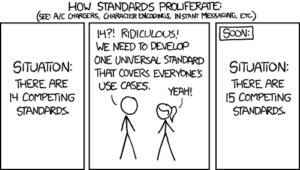Broadcast & Distribution – Hardware manufacturers and standards developers have often clashed when it comes to inter-compatibility and longevity of solutions. Once a solution takes hold in the marketplace, it can be very difficult to evolve to better platforms if it requires consumers to replace expensive hardware.
Courtesy, xkcd. Licensed under Creative Commons.
Years ago, when a color television standard was developed in the US, there were two major proponents, RCA and CBS. Although the CBS system was judged at having better color reproduction, the RCA system won out, in large part due to its backward compatibility with legacy black-and-white receivers.
But incompatibility can be rationalized, given sufficient justification. Digital HDTV transmission, completely incompatible with legacy analog television transmission, won out over backwards-compatible “enhancement” approaches, in part due to the overwhelming superior performance of the digital approach, together with calls for more efficient and new uses of the spectrum.
Another aspect of this issue is the choice of firmware that is shipped with products supporting new content display formats. As one example, Panasonic this year chose ViXS’ XCode 6403 System-on-Chip (SoC) for its latest Ultra HD television line-up. In using ViXS’ solution, Panasonic said it is the first television manufacturer to launch a consumer-ready television with the ability to decode full 3840×2160 Ultra HD content at 10 bits per color and 60 frames per second.
But no sooner had this TV hit the shelves than owners started complaining that the set could not properly display UHD content received from Netflix. Indeed, Panasonic seemed to agree with this finding at TechRadar, with marketing director Simon Parkinson quoted as saying, “It’s unfortunate, but we won’t be able to offer Netflix 4K on this particular model”. The limitation apparently arose in the AX800 model, due to a “shortcoming” of the set’s HEVC decoder chip configuration.
However, while Panasonic did not respond to our requests for more details, ViXS VP of Marketing & Business Development David Jones was quick to offer us his comments, calling the TechRadar article “incorrect,” and adding that Panasonic has also disclaimed its earlier comment. Indeed, Panasonic now says, and independent sources have confirmed, that after a firmware update of October 9, the AX800 can now play back Netflix’s UHD content. (Toshiba and Sharp have also announced they are designing in ViXS to their UHDTV’s for 10-bit HEVC UHDTV, which should also support Netflix.)
Why the original problem? While we don’t know the exact reasons, we know that support for a newly-emerging standard like HEVC has its challenges. Not all features of a standard are always fully supported in all silicon, especially early on, before a critical mass has developed in deployed products. This is especially true for HEVC, which is much more complex to decode than its forerunners AVC and MPEG-2.
One way to forestall these potential problems is to keep as much functionality generic in the silicon, so that a firmware update can remove an unseen gremlin. But that requires an almost prescient-like ability in the silicon designers, trying to predict problems before they happen, as well as a DSP-like architecture that often conflicts with very-high-speed signal processing.
The other good practice is for content providers like Netflix to be part of the standards-development process, so that their emerging applications have strong support. The challenge there is that the standards process is long and slow, while the content distribution business must be fiercely quick to adapt to changing markets. It is exactly that situation that led to the rise (and ample success) of satellite content distribution, a model that could serve useful as digital content delivery continues to evolve. – Aldo Cugnini

